Khảo sát về tần suất sử dụng các chiến lược học tập của sinh viên năm hai chuyên ngữ trong việc học các kỹ năng nghe nói tiếng Anh ở Trường Đại học Sài Gòn
Bài viết khảo sát việc tự học của sinh viên năm thứ hai chuyên ngữ trong các lớp học kỹ năng tiếng Anh
tại Đại học Sài Gòn với bốn vấn đề trọng tâm: động lực của người học để tham gia vào việc tự học, thái
độ của họ đối với việc tự học, mức độ tự tin, và tần suất sử dụng các chiến lược học tập cho các kỹ năng
ngôn ngữ của họ. 176 sinh viên chuyên ngữ năm hai tại Đại học Sài Gòn đã trả lời bảng câu hỏi khảo sát
về tần suất sử dụng các chiến lược học tập trong các giờ học kỹ năng Nghe, Nói. Nghiên cứu cho thấy
sinh viên được khảo sát thể hiện tần suất sử dụng các chiến lược học tập trong kỹ năng Nghe, Nói Tiếng
Anh rất cao với 78% đối với kỹ năng Nói và 68% đối với kỹ năng Nghe. Bên cạnh đó, các chiến lược
học tập được áp dụng phổ biến nhất là siêu nhận thức, nhận thức và khen thưởng trong khi các chiến
lược học tập liên quan đến trí nhớ, tình cảm và xã hội không được khai thác triệt để. Từ đó, có thể thấy
rằng đối tượng sinh viên được khảo sát có thể trở thành những người tự học thật sự rất tích cực. Nghiên
cứu cũng đưa ra một số đề xuất thực tiễn trong việc trau dồi cho người học sử dụng các chiến lược học
tập trong các kỹ năng Nghe, Nói, đó cũng là một phần trong việc thúc đẩy sự tự học của họ trong việc
học tiếng Anh.
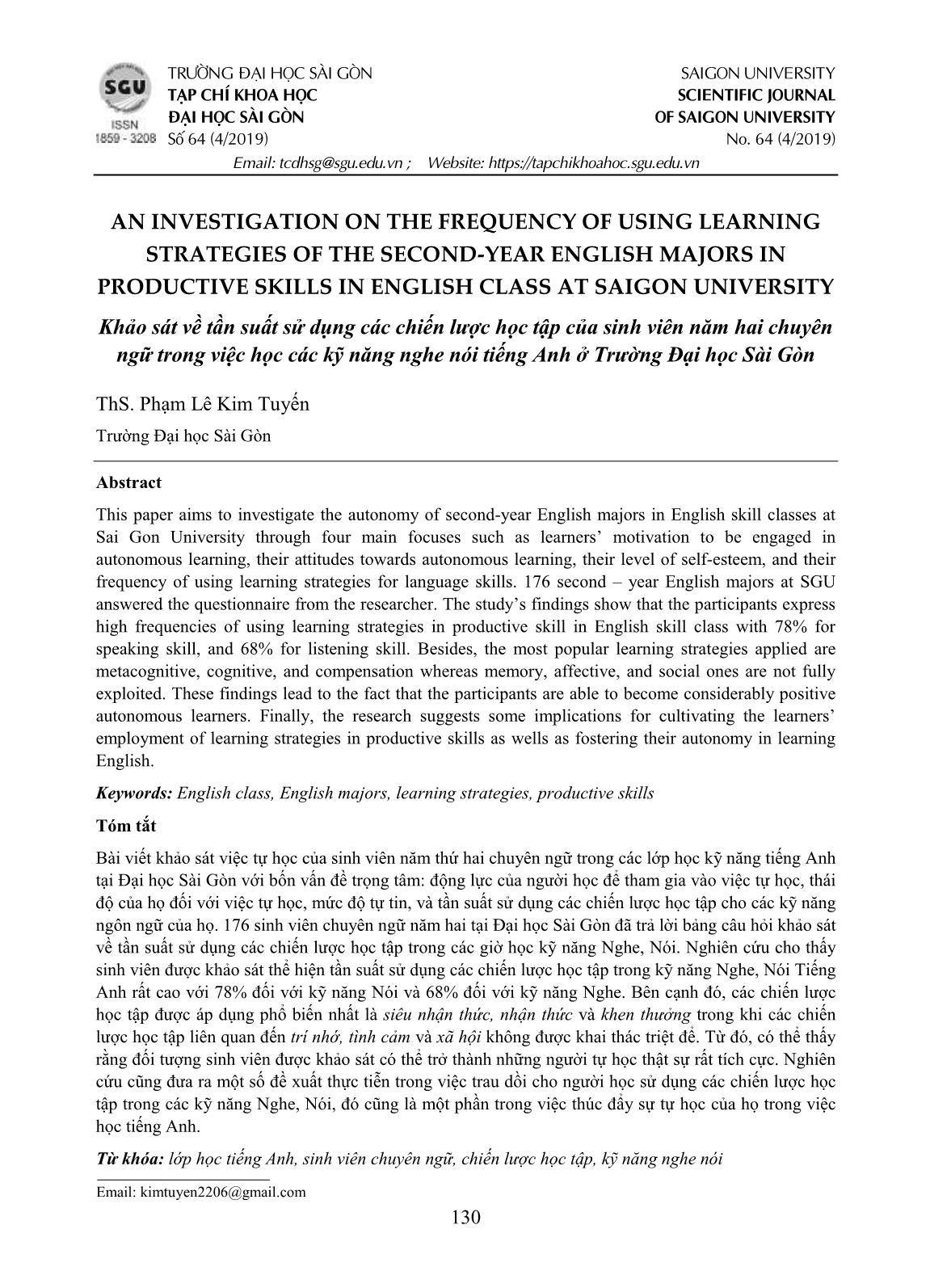
Trang 1
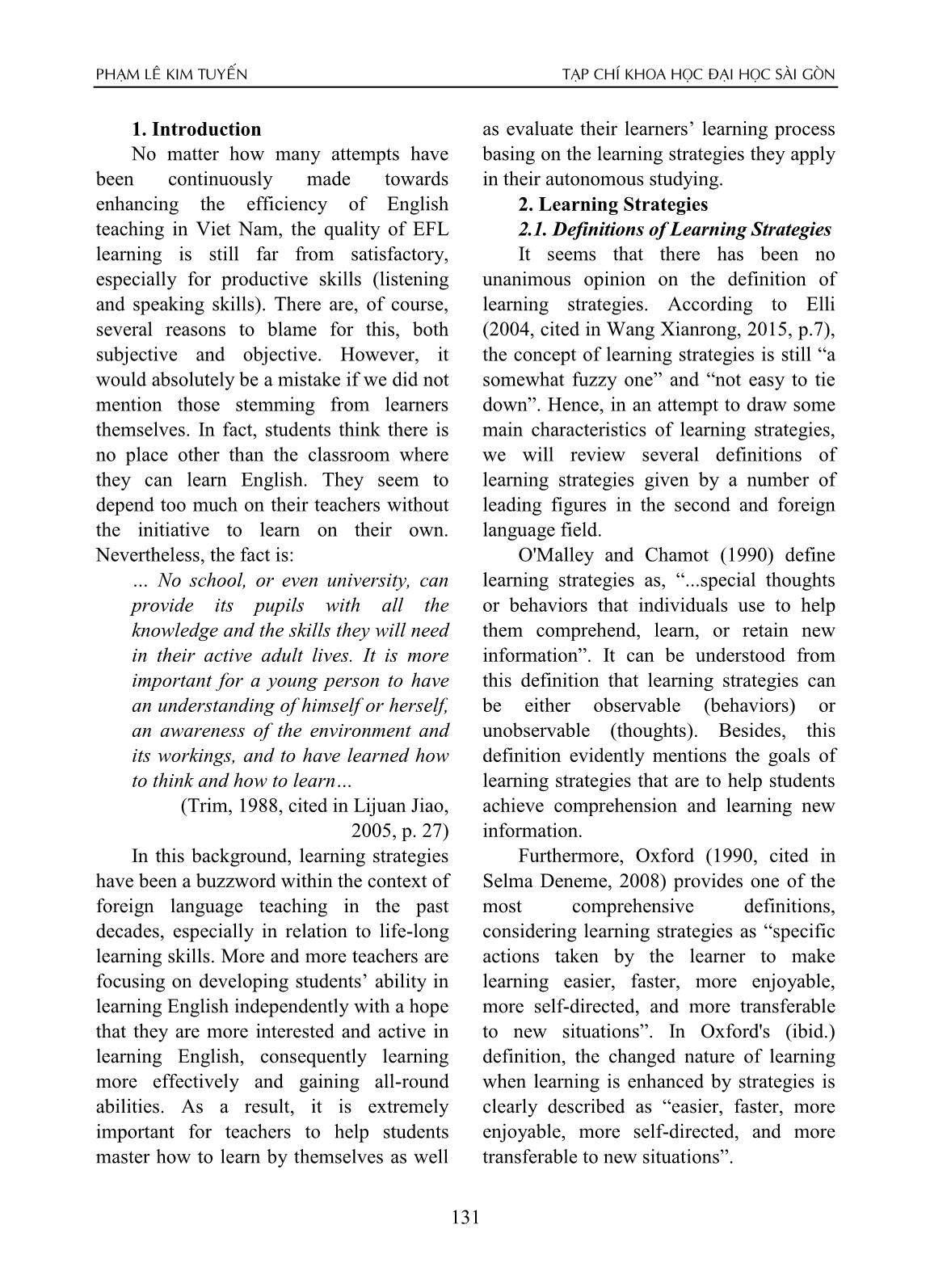
Trang 2
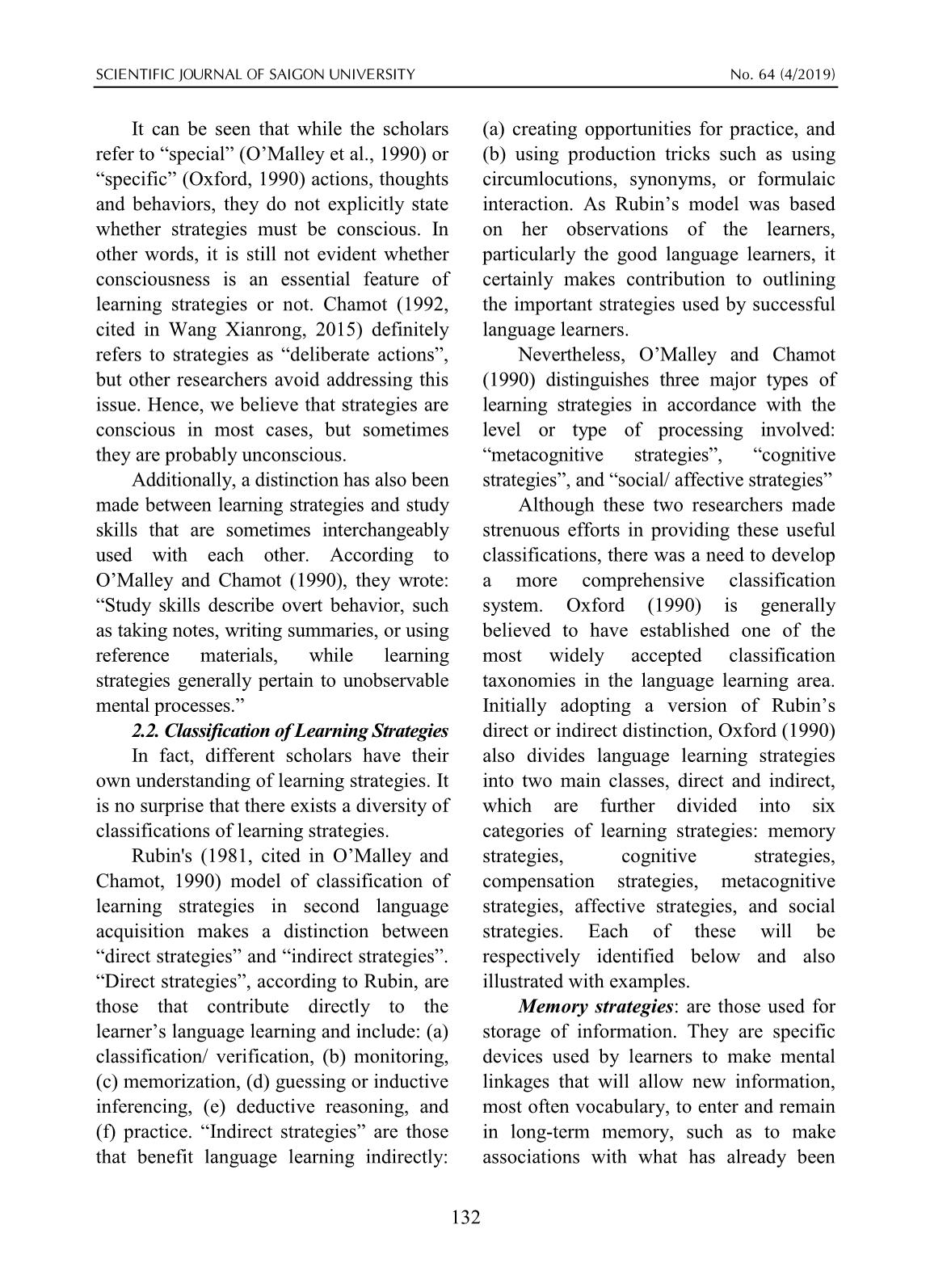
Trang 3
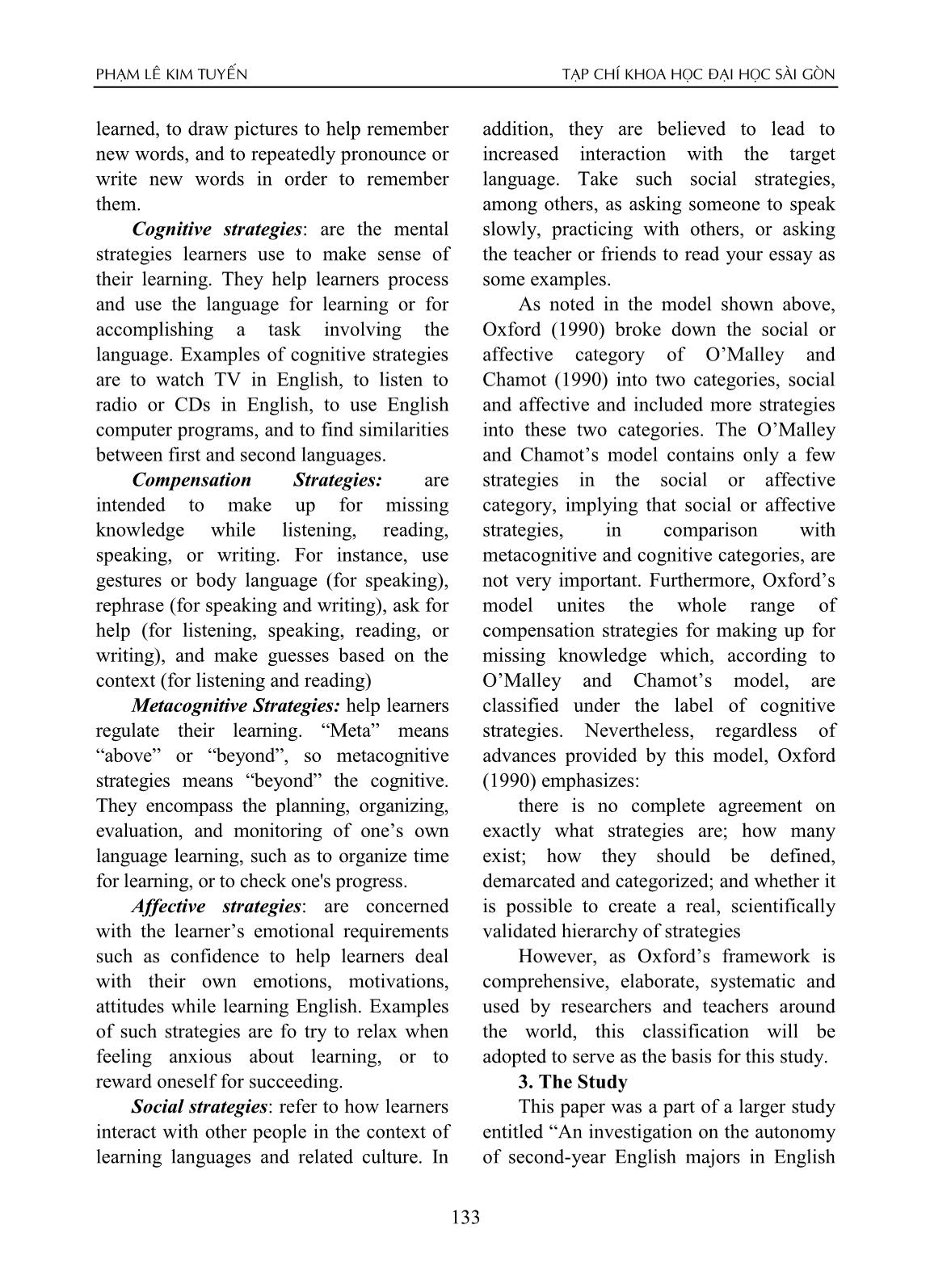
Trang 4
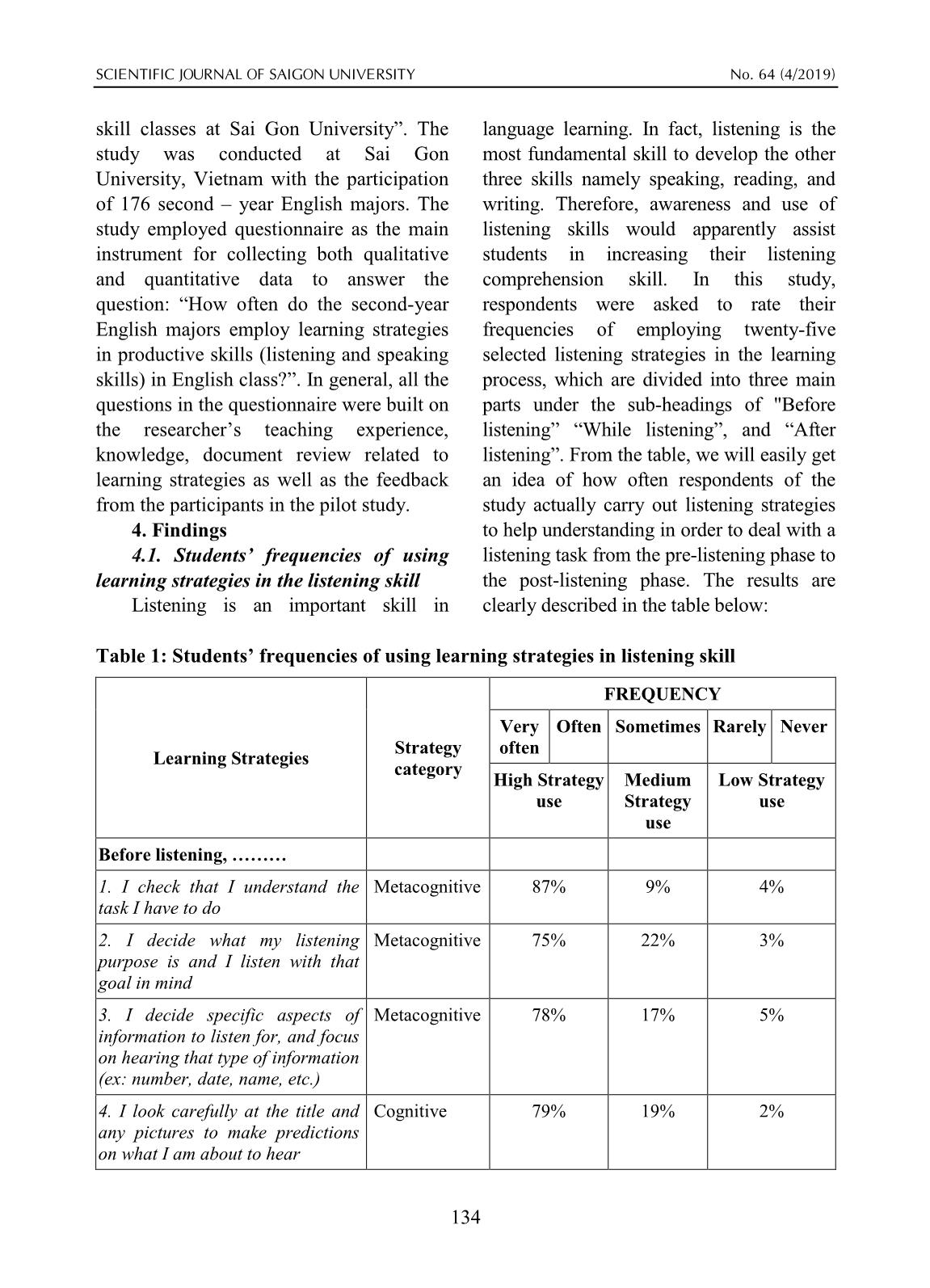
Trang 5
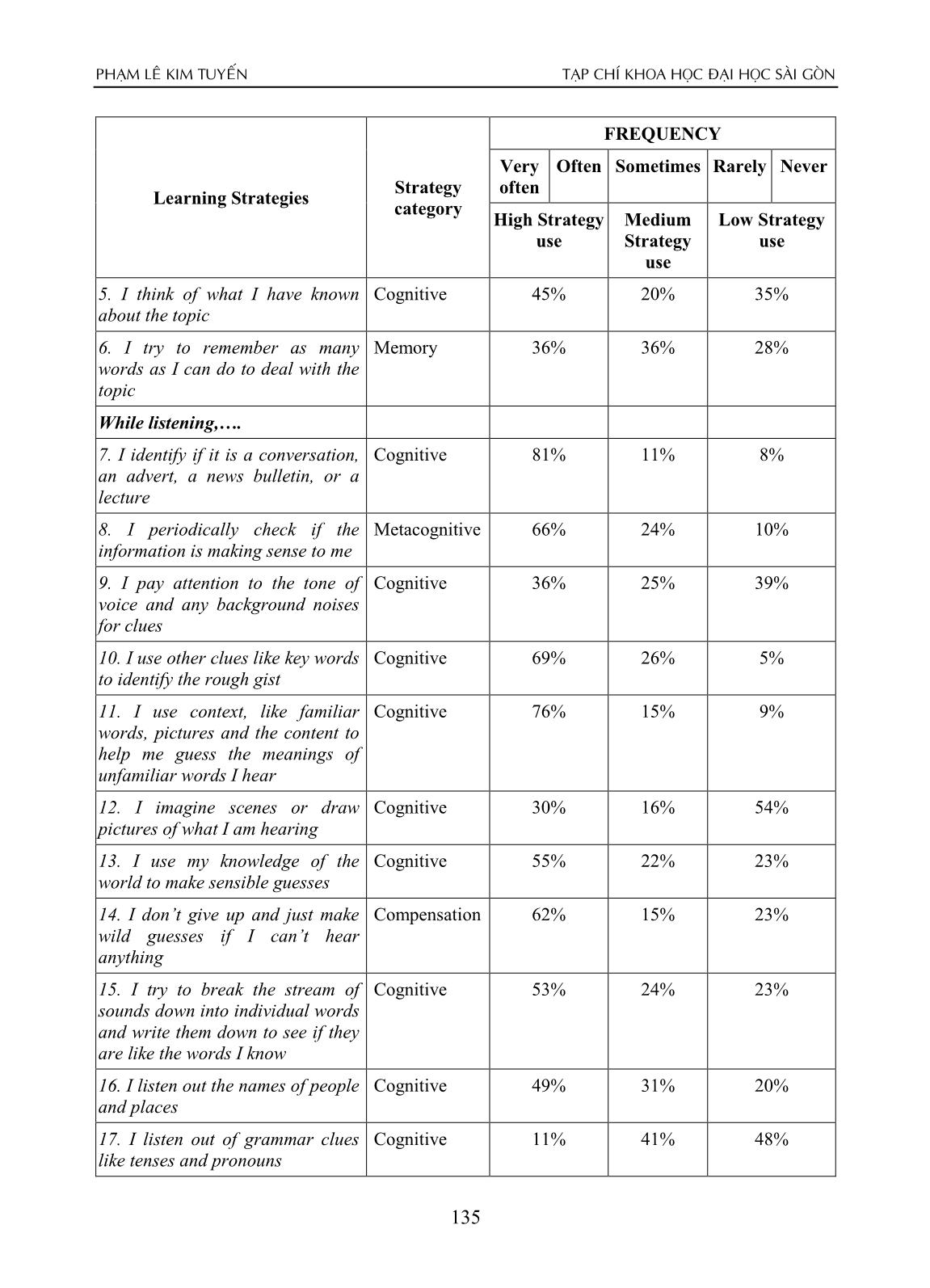
Trang 6
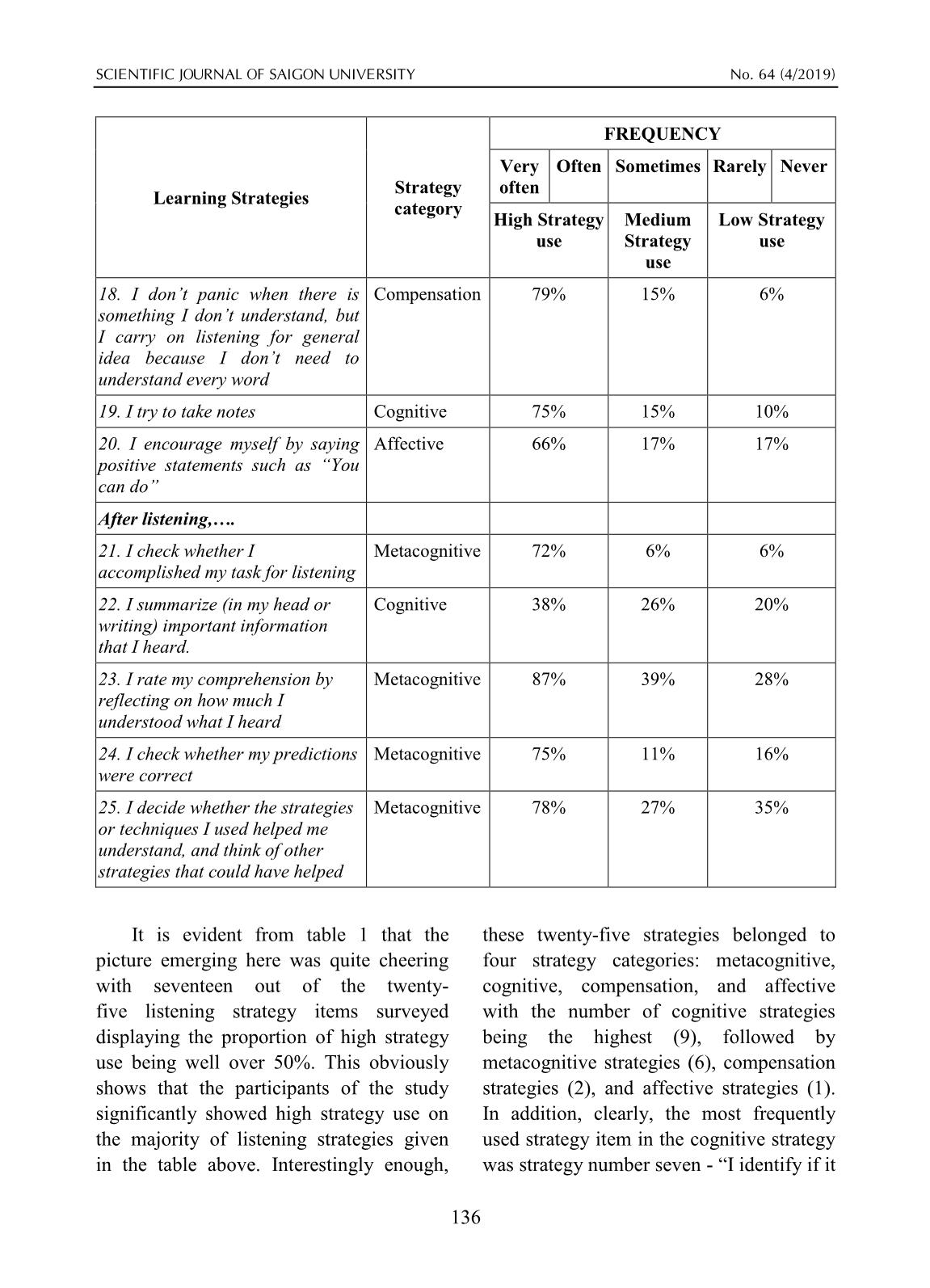
Trang 7
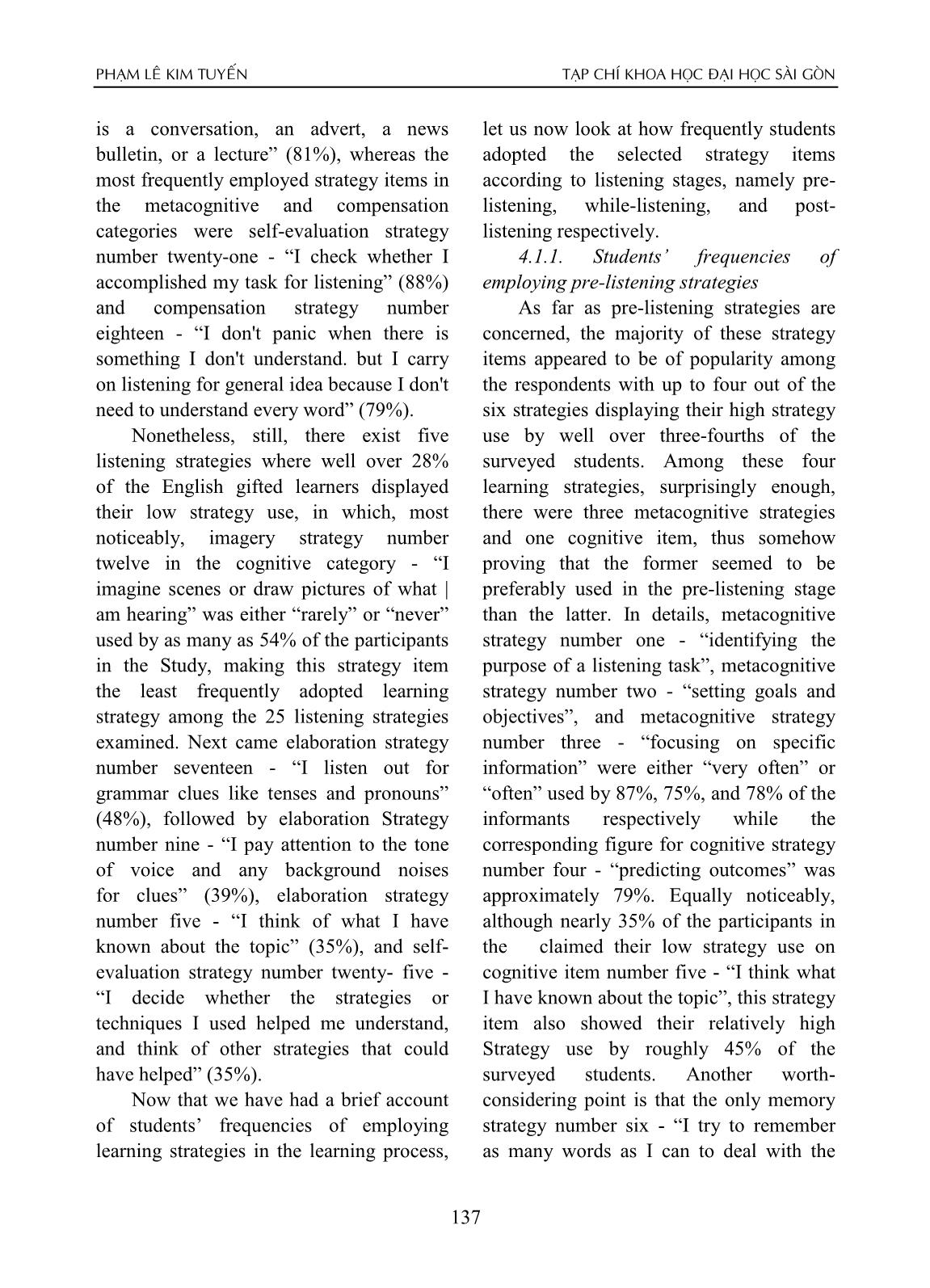
Trang 8
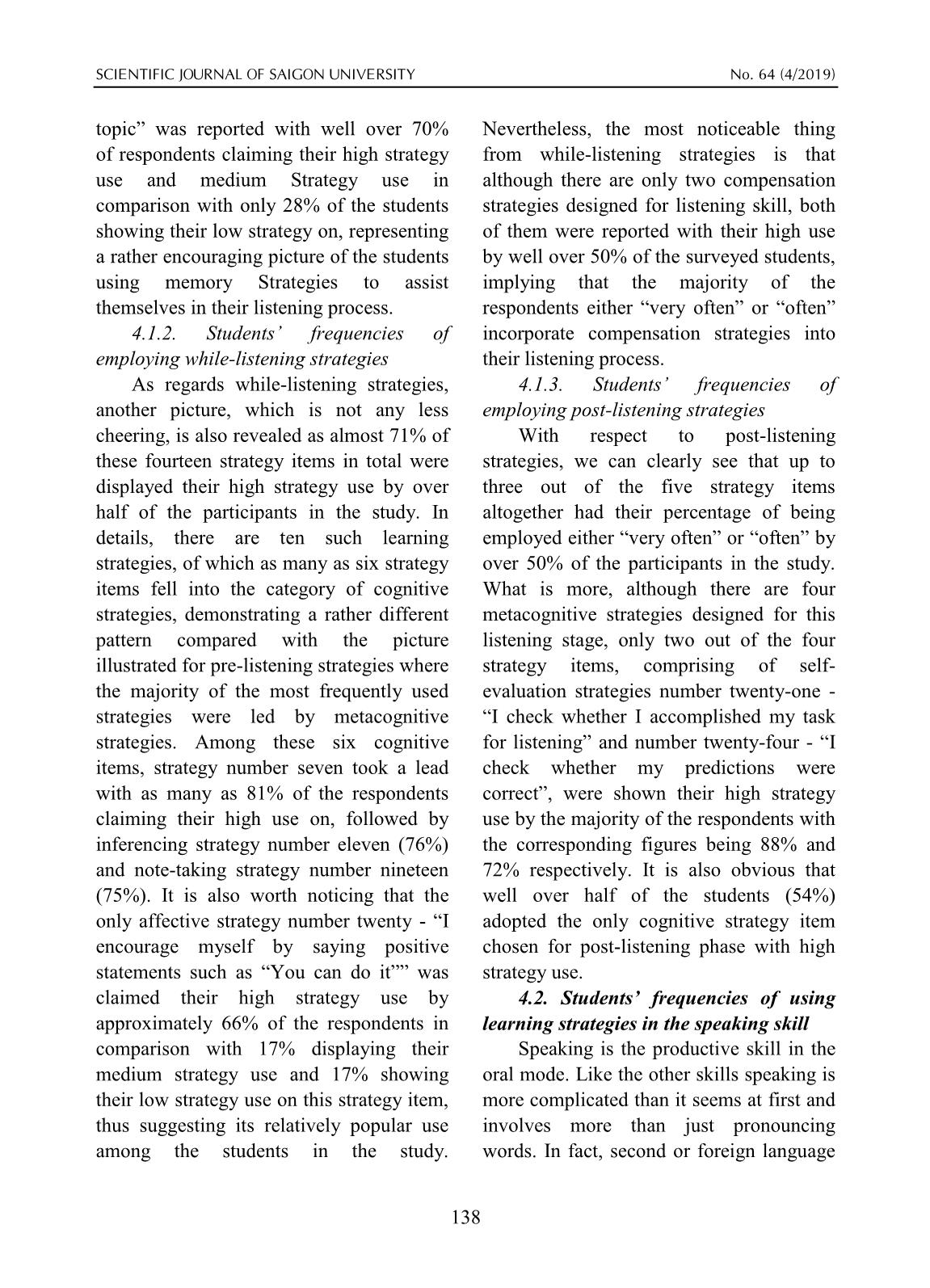
Trang 9
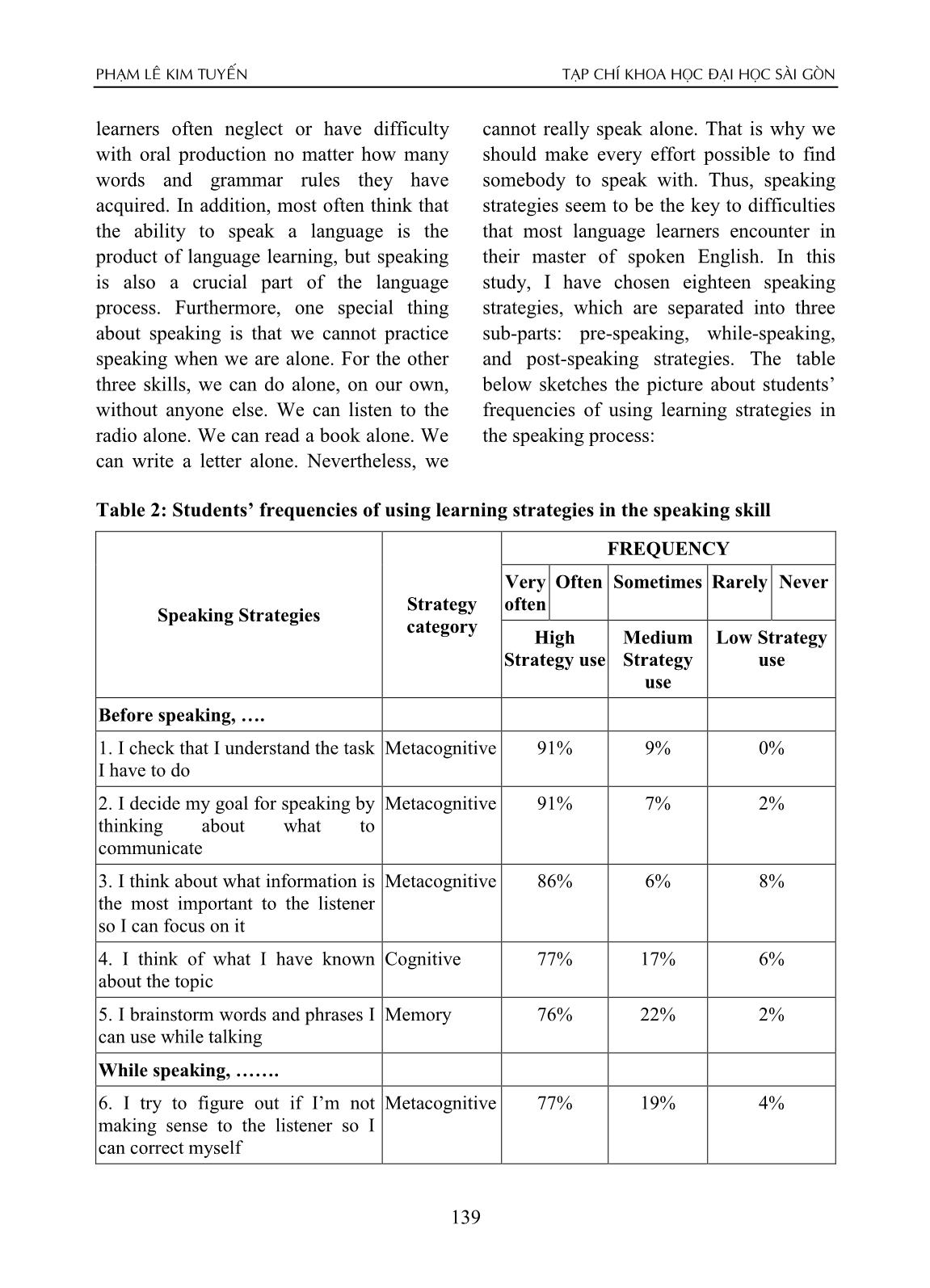
Trang 10
Tải về để xem bản đầy đủ
Tóm tắt nội dung tài liệu: Khảo sát về tần suất sử dụng các chiến lược học tập của sinh viên năm hai chuyên ngữ trong việc học các kỹ năng nghe nói tiếng Anh ở Trường Đại học Sài Gòn
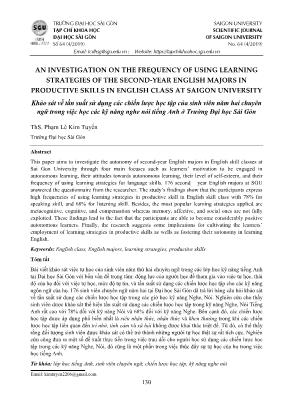
TRƯỜNG ĐẠI HỌC SÀI GÒN SAIGON UNIVERSITY TẠP CHÍ KHOA HỌC SCIENTIFIC JOURNAL ĐẠI HỌC SÀI GÒN OF SAIGON UNIVERSITY Số 64 (4/2019) No. 64 (4/2019) Email: tcdhsg@sgu.edu.vn ; Website: https://tapchikhoahoc.sgu.edu.vn 130 AN INVESTIGATION ON THE FREQUENCY OF USING LEARNING STRATEGIES OF THE SECOND-YEAR ENGLISH MAJORS IN PRODUCTIVE SKILLS IN ENGLISH CLASS AT SAIGON UNIVERSITY Khảo sát về tần suất sử dụng các chiến lược học tập của sinh viên năm hai chuyên ngữ trong việc học các kỹ năng nghe nói tiếng Anh ở Trường Đại học Sài Gòn ThS. Phạm Lê Kim Tuyến Trường Đại học Sài Gòn Abstract This paper aims to investigate the autonomy of second-year English majors in English skill classes at Sai Gon University through four main focuses such as learners’ motivation to be engaged in autonomous learning, their attitudes towards autonomous learning, their level of self-esteem, and their frequency of using learning strategies for language skills. 176 second – year English majors at SGU answered the questionnaire from the researcher. The study’s findings show that the participants express high frequencies of using learning strategies in productive skill in English skill class with 78% for speaking skill, and 68% for listening skill. Besides, the most popular learning strategies applied are metacognitive, cognitive, and compensation whereas memory, affective, and social ones are not fully exploited. These findings lead to the fact that the participants are able to become considerably positive autonomous learners. Finally, the research suggests some implications for cultivating the learners’ employment of learning strategies in productive skills as wells as fostering their autonomy in learning English. Keywords: English class, English majors, learning strategies, productive skills Tóm tắt Bài viết khảo sát việc tự học của sinh viên năm thứ hai chuyên ngữ trong các lớp học kỹ năng tiếng Anh tại Đại học Sài Gòn với bốn vấn đề trọng tâm: động lực của người học để tham gia vào việc tự học, thái độ của họ đối với việc tự học, mức độ tự tin, và tần suất sử dụng các chiến lược học tập cho các kỹ năng ngôn ngữ của họ. 176 sinh viên chuyên ngữ năm hai tại Đại học Sài Gòn đã trả lời bảng câu hỏi khảo sát về tần suất sử dụng các chiến lược học tập trong các giờ học kỹ năng Nghe, Nói. Nghiên cứu cho thấy sinh viên được khảo sát thể hiện tần suất sử dụng các chiến lược học tập trong kỹ năng Nghe, Nói Tiếng Anh rất cao với 78% đối với kỹ năng Nói và 68% đối với kỹ năng Nghe. Bên cạnh đó, các chiến lược học tập được áp dụng phổ biến nhất là siêu nhận thức, nhận thức và khen thưởng trong khi các chiến lược học tập liên quan đến trí nhớ, tình cảm và xã hội không được khai thác triệt để. Từ đó, có thể thấy rằng đối tượng sinh viên được khảo sát có thể trở thành những người tự học thật sự rất tích cực. Nghiên cứu cũng đưa ra một số đề xuất thực tiễn trong việc trau dồi cho người học sử dụng các chiến lược học tập trong các kỹ năng Nghe, Nói, đó cũng là một phần trong việc thúc đẩy sự tự học của họ trong việc học tiếng Anh. Từ khóa: lớp học tiếng Anh, sinh viên chuyên ngữ, chiến lược học tập, kỹ năng nghe nói Email: kimtuyen2206@gmail.com PHẠM LÊ KIM TUYẾN TẠP CHÍ KHOA HỌC ĐẠI HỌC SÀI GÒN 131 1. Introduction No matter how many attempts have been continuously made towards enhancing the efficiency of English teaching in Viet Nam, the quality of EFL learning is still far from satisfactory, especially for productive skills (listening and speaking skills). There are, of course, several reasons to blame for this, both subjective and objective. However, it would absolutely be a mistake if we did not mention those stemming from learners themselves. In fact, students think there is no place other than the classroom where they can learn English. They seem to depend too much on their teachers without the initiative to learn on their own. Nevertheless, the fact is: No school, or even university, can provide its pupils with all the knowledge and the skills they will need in their active adult lives. It is more important for a young person to have an understanding of himself or herself, an awareness of the environment and its workings, and to have learned how to think and how to learn (Trim, 1988, cited in Lijuan Jiao, 2005, p. 27) In this background, learning strategies have been a buzzword within the context of foreign language teaching in the past decades, especially in relation to life-long learning skills. More and more teachers are focusing on developing students’ ability in learning English independently with a hope that they are more interested and active in learning English, consequently learning more effectively and gaining all-round abilities. As a result, it is extremely important for teachers to help students master how to learn by themselves as well as evaluate their learners’ learning process basing on the learning strategies they apply in their autonomous studying. 2. Learning Strategies 2.1. Definitions of Learning Strategies It seems that there has been no unanimous opinion on the definition of learning strategies. According to Elli (2004, cited in Wang Xianrong, 2015, p.7), the concept of learning strategies is still “a somewhat fuzzy one” and “not easy to tie down”. Hence, in an attempt to draw some main characteristics of learning strategies, we will review several definitions of learning strategies given by a number of leading figures in the second and foreign language field. O'Malley and Chamot (1990) define learning strategies as, “...special thoughts or behaviors that individuals use to help them comprehend, learn, or retain new information”. It can be understood from this definition that learning strategies can be either observable (behaviors) or unobservable (thoughts). Besides, this definiti ... HỌC SÀI GÒN 139 learners often neglect or have difficulty with oral production no matter how many words and grammar rules they have acquired. In addition, most often think that the ability to speak a language is the product of language learning, but speaking is also a crucial part of the language process. Furthermore, one special thing about speaking is that we cannot practice speaking when we are alone. For the other three skills, we can do alone, on our own, without anyone else. We can listen to the radio alone. We can read a book alone. We can write a letter alone. Nevertheless, we cannot really speak alone. That is why we should make every effort possible to find somebody to speak with. Thus, speaking strategies seem to be the key to difficulties that most language learners encounter in their master of spoken English. In this study, I have chosen eighteen speaking strategies, which are separated into three sub-parts: pre-speaking, while-speaking, and post-speaking strategies. The table below sketches the picture about students’ frequencies of using learning strategies in the speaking process: Table 2: Students’ frequencies of using learning strategies in the speaking skill Speaking Strategies Strategy category FREQUENCY Very often Often Sometimes Rarely Never High Strategy use Medium Strategy use Low Strategy use Before speaking, . 1. I check that I understand the task I have to do Metacognitive 91% 9% 0% 2. I decide my goal for speaking by thinking about what to communicate Metacognitive 91% 7% 2% 3. I think about what information is the most important to the listener so I can focus on it Metacognitive 86% 6% 8% 4. I think of what I have known about the topic Cognitive 77% 17% 6% 5. I brainstorm words and phrases I can use while talking Memory 76% 22% 2% While speaking, . 6. I try to figure out if I’m not making sense to the listener so I can correct myself Metacognitive 77% 19% 4% SCIENTIFIC JOURNAL OF SAIGON UNIVERSITY No. 64 (4/2019) 140 Speaking Strategies Strategy category FREQUENCY Very often Often Sometimes Rarely Never High Strategy use Medium Strategy use Low Strategy use 7. I focus on topics that I know how to talk about, and I use language structures I am familiar with so that others can understand me Metacognitive 85% 14% 1% 8. I imagine or draw a picture or situation that I want to talk about to guide me when I’m speaking Cognitive 49% 19% 32% 9. If I don’t know the word for something, I describe it Compensation 63% 24% 13% 10. If I don’t know the word for something, I substitute what I do know how to say Compensation 52% 40% 8% 11. I use mime or gestures or a facial expression when I can’t think of the word for something Compensation 63% 30% 7% 12. If I don’t know the word for something, I ask for help Compensation 40% 24% 36% 13. If I don’t know the word for something, I show I need help such as pausing, a puzzled expression, etc. Compensation 37% 32% 31% 14. I try to guess what the other person will say next in English Compensation 29% 27% 44% 15. I use “stalling strategies” like “Well, now let me see, as a matter of fact, let me think, I have never given it a thought before, etc. Compensation 59% 31% 10% 16. I encourage myself by saying positive statements such as “You can do” Affective 66% 17% 17% After speaking, . 17. I check whether I accomplished my goal for speaking Metacognitive 79% 15% 6% 18. I rate how well I did Metacognitive 70% 17% 13% PHẠM LÊ KIM TUYẾN TẠP CHÍ KHOA HỌC ĐẠI HỌC SÀI GÒN 141 The table tells us that over three-fourth of the total eighteen speaking strategies examined had their rate of high strategy use accounting for well over 50%, which appeared to be somehow very encouraging compared with listening and reading strategies. In details, there were fourteen strategies being used either “very often” or “often” by almost half of the participants, in which up two strategies, strategy number one and number two, were claimed with their high strategy use by well over 90% of the total students. With respect to low strategy use, noticeably enough, only four strategies were reported by over 30% of the students. Most prominently, strategy number fourteen - “ I try to guess what the other person will say next in English” was either “rarely” or “never” employed by nearly 44% of the informants, implying clearly its unpopularity among all the speaking strategies surveyed. Next came strategy number twelve (36%), number eight (32%), and number thirteen (31%). Another evident point to know from the table is that none of the participants displayed their low strategy use on the first speaking strategy - “I check that I understand the task I have to do”, making it the only learning strategy all the subjects in the study showed either high strategy use or medium strategy use on. 4.2.1. Students’ frequencies of employing pre-speaking strategies All the pre-speaking strategies, encouragingly enough, were employed with high strategy use by the majority of the students, which seemingly bore a strong resemblance to pre- reading strategies. It is apparent that well over 75% of the students either “very often” or “often” adopted all the five selected pre- speaking strategies, thus revealing their even greater popularity among the participants in the study in comparison with pre-reading strategies. Specifically, nearly 91% of the subjects reported their high strategy use on metacognitive strategies number one - “Identifying the purpose of a learning task’ and number two - “Setting goals and objectives” making them the two most frequently used pre- speaking strategies. What is more, there seemed to be a gradual decline in the proportion of students showing their high strategy on metacognitive strategy number three, cognitive strategy number four, and memory strategy number five with the corresponding figures being 86%, 77%, and 76%. In fact, the memory strategy as a pre-speaking strategy was implemented with the greater rate of high strategy use than memory strategies of the pre-listening and pre-reading stages. Furthermore, from the result above, we can see a great dominance of metacognitive strategies over cognitive strategies or memory ones at the pre-reading stage. 4.2.2. Students’ frequencies of employing while-speaking strategies As far as while-speaking strategies are concerned, as many as seven out of the eleven strategy items altogether were reported with high strategy use by well over half of the students. These seven strategies fell into three categories of strategy including metacognitive, compensation, and affective, in which the number of compensation strategies led with four items followed by metacognitive (2) and affective (1), but it was metacognitive strategy that SCIENTIFIC JOURNAL OF SAIGON UNIVERSITY No. 64 (4/2019) 142 took a lead in terms of frequencies. It is quite clear that metacognitive strategy number seven - “I focus on topics that I know how to talk about, and I use language structures I am familiar with so that others can understand me” had the highest percentage of high strategy use (85%), and another metacognitive strategy number six - “I try to figure out if I'm not making sense to the listener so I can correct myself” came second with approximately 77% of the respondents showing high strategy use on. Another noticeable thing is that of the seven compensation strategies designed for speaking skill, interestingly enough, although the four strategies, comprising of strategies number nine, eleven, fifteen, and ten, were reported with their proportion of high strategy use being 63%, 63%, 59%, and 52% respectively, there still lie the other three strategies, all of which were listed in the table summarizing the fourteen least frequently used strategy items. Besides, not less noticeably, cognitive strategy number eight - “I imagine or draw a picture or situation that I want to talk about to help guide me when I'm speaking”, by the same token, appeared to be among the fourteen least frequently used strategy items with the proportion of low strategy use accounting for nearly 32%. Furthermore, it is clearly shown that the only affective strategy - “Encouraging oneself’ turned out to be relatively popular among the respondents because as many as 66% of the surveyed students claimed that they either “very often” or “often” adopted it for their speaking process, proving once and again the undeniable importance of the affective strategy to facilitate the learning process. 4.2.3. Students’ frequencies of employing post-speaking strategies With respect to post-speaking strategies, both of the metacognitive strategies chosen specially for this speaking stage were shown their high strategy use by over 70% of the participants, displaying a rather encouraging picture of students’ frequencies of employing post-speaking strategies. In details, metacognitive strategy number seven - “I check whether I accomplished my goal for speaking” was either “very often” or “often” adopted by up to 79% of the informants, closely followed by metacognitive strategy number eighteen - “I rate how well I did it” with the corresponding figure being 70%. 5. Discussion and Recommendations Table 3: Breakdown of learning strategies by productive skills Strategy category/ Language skill Listening Speaking Total Metacognitive 8 7 15 Cognitive 13 2 15 Compensation 2 7 9 Memory 1 1 2 Affective 1 1 2 Social 0 0 0 Total 25 18 43 PHẠM LÊ KIM TUYẾN TẠP CHÍ KHOA HỌC ĐẠI HỌC SÀI GÒN 143 From Table 3, the picture for students’ frequencies of using learning strategies in productive-skill learning process emerging here is rather comforting. Among 43 learning strategies categorized by language skills, there are 25 listening strategies and 18 speaking strategies in total. This means that the number of learning strategies is fairly equally distributed among two productive skills. With respect to the six strategy categories, interestingly enough, we can see that metacognitive and cognitive strategies appear to dominate in listening skill strategies, whereas both metacognitive strategies and compensation skills seem to exert their dominance in speaking skill. In other words, the most obvious difference between the speaking strategy pattern and that of listening skill is that compensation strategies proved their dominance over both metacognitive and cognitive strategies in the speaking skill. Furthermore, not less interestingly, only one memory strategy item and one affective strategy item designed for each language skill is carefully chosen to discuss the students’ frequencies of using learning strategies for these two strategy categories. Last but not least, it is also apparent that although there still exist enormous disparities about what strategy categories were preferred for each phase of language skills, most of the total students in the study displayed preferences of adopting metacognitive strategies with high strategy use over other strategy categories both before carrying out and after finishing a language task. All in all, by taking all these main findings mentioned above into consideration, we can arrive at the conclusion that surveyed second-year English majors at SGU demonstrate a quite high level of employing a range of learning strategies in productive skills in English class to study effectively and independently. To a certain extent, it means that they are capable of becoming autonomous learners, which has been the final target of many learning and teaching methodologies. With a desire to further promote the autonomy of English majors at SGU, bearing in my mind that although it is rather encouraging to explore that the majority of the students reported their high strategy use on most of the learning strategies, it is also apparent that students do not fully exploit the range of learning strategies given. Therefore, it is highly recommended that English teachers should pay more attention to empower their students with the ability of learning how to learn. For example, more concern should be invested in raising the students’ awareness of adopting social strategies as well as providing learner training because social strategies, among the six strategy categories, appeared to be the least fully exploited among the six strategy categories. It is the teacher's role to offer their students a great deal of guidance in order to help them decide on what strategies that work for them and experiment with those strategies, with which they are not so familiar. SCIENTIFIC JOURNAL OF SAIGON UNIVERSITY No. 64 (4/2019) 144 REFERENCES Lijuan, J. (2015). Promoting EFL Learner Autonomy. Sino-US English Teaching, 2 (5), 27-30. O’Malley, J. & Chamot, A. (1990). Learning strategies in second language acquisition. Cambridge: Cambridge University Press. Oxford, R. (1990). Language Learning Strategies- What Every Teacher Should Know. New York: Newbury House Publisher. Selma, D. (2008) Language Learning Strategy Preferences of Turkish Students. Journal of Language and Linguistic Studies, 4 (2). Wang, X. (2015). A Tentative Study on Language Learning Strategies of Non-English Majors at Teachers’ Colleges. M.A Thesis. Anhui Province: Anhui University. Ngày nhận bài: 29/3/2019 Biên tập xong: 15/4/2019 Duyệt đăng: 20/4/2019
File đính kèm:
 khao_sat_ve_tan_suat_su_dung_cac_chien_luoc_hoc_tap_cua_sinh.pdf
khao_sat_ve_tan_suat_su_dung_cac_chien_luoc_hoc_tap_cua_sinh.pdf

